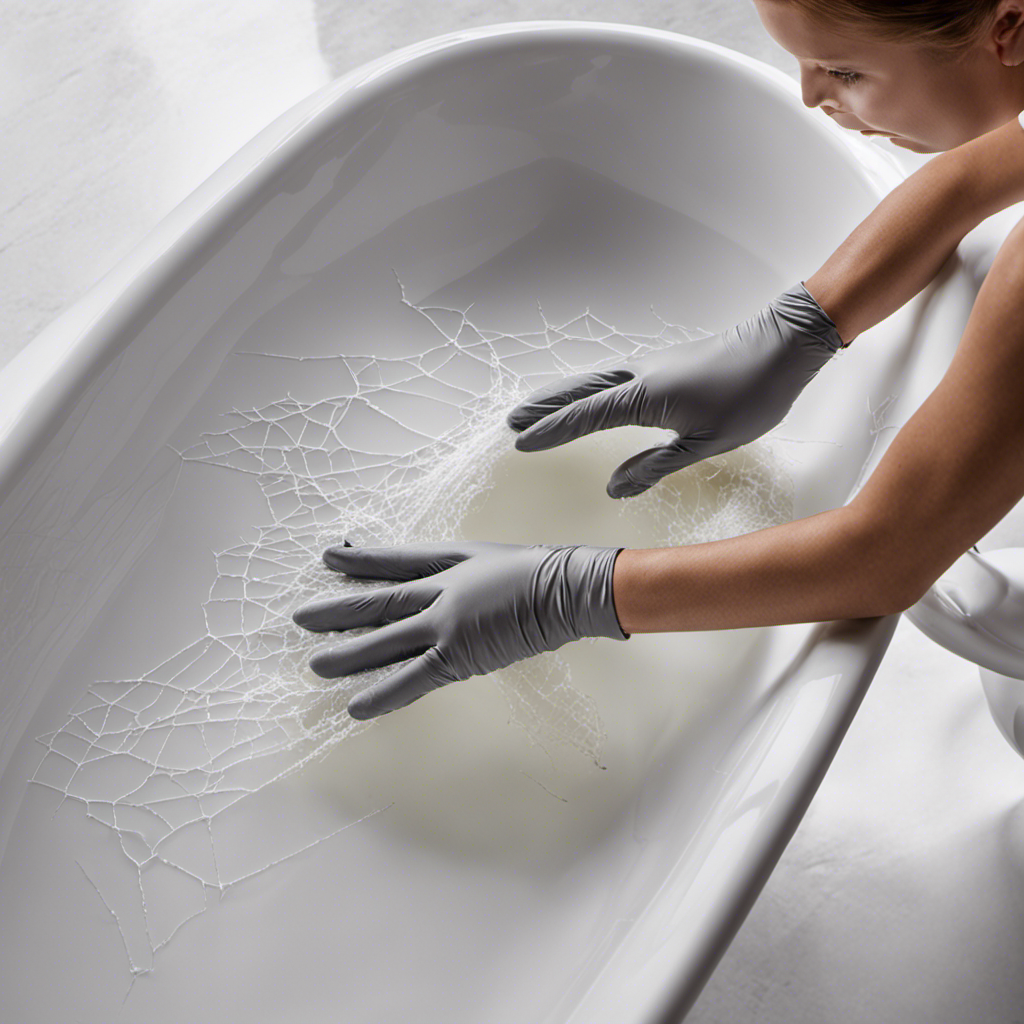As a homeowner, I know that accidents happen. One day, you may discover a hole in your bathtub, causing water to leak and potentially damaging your bathroom floor. But fear not! In this article, I will guide you step-by-step on how to repair that hole and restore your bathtub to its former glory.
So grab your tools and let’s dive into the world of bathtub repair, where we’ll patch, sand, and seal our way to a flawless finish.
Key Takeaways
- Carefully examine the hole to determine its size, shape, and location.
- Assess the surrounding area for water damage or structural issues.
- Use appropriate tools and materials such as sandpaper, a drill, and a caulking gun.
- Clean the bathtub thoroughly, apply a filler and patching compound, and finish with a primer and bathtub paint.
Assess the Extent of the Damage
Before you can begin repairing the hole, you’ll need to assess the extent of the damage. Start by carefully examining the hole to determine its size and shape. Assess the surrounding area for any signs of water damage or other structural issues.
Look for cracks or chips in the bathtub material that may have contributed to the hole. Next, consider the location of the hole. Is it on the surface or in a hard-to-reach area? This will affect the repair options available to you.
Finally, evaluate the overall condition of the bathtub. Is it old and worn, or is the hole an isolated incident? This will help you determine whether a simple patch or a more extensive repair is needed.
Gather the Necessary Tools and Materials
When it comes to repairing a hole in a bathtub, having the right tools is essential. The tools you will need include:
- A putty knife
- Sandpaper
- A drill
- A mixing paddle
- A caulking gun
These tools will help you remove the damaged area, prepare the surface, and apply the necessary materials for a successful repair.
Essential Tools for Repair
To repair a hole in your bathtub, you’ll need a few essential tools. These tools are crucial for executing the bathtub repair techniques effectively.
Firstly, you will require a putty knife to remove any loose material around the hole and create a smooth surface for repair.
Next, a fiberglass repair kit is essential for patching the hole and ensuring its durability. This kit typically includes fiberglass cloth, epoxy resin, and a mixing tray.
Additionally, a sandpaper or sanding block is necessary to smooth out the repaired area and blend it seamlessly with the surrounding surface.
Lastly, a caulk gun and bathtub caulk are needed to seal and waterproof the repaired hole.
When considering the bathtub repair cost comparison, investing in these essential tools will save you money in the long run by avoiding the need for professional repairs.
Choosing the Right Materials
It’s important to choose the right materials for patching up any damage in your bathtub. When it comes to repairing a hole, there are several options to consider.
One option is using a fiberglass repair kit. These kits typically include a resin and a hardener that, when mixed together, create a strong and durable patch.
Another option is using epoxy putty. This putty is easy to work with and can be molded to fit the shape of the hole.
Additionally, you can also use bathtub repair kits that come with a filler compound specifically designed for bathtub repairs. These kits often include a filler, a bonding agent, and a catalyst.
Comparing these different repair options, it’s important to consider factors such as the size of the hole, the level of damage, and your personal preferences. With the right materials, you can effectively repair the hole in your bathtub and restore its functionality.
Speaking of restoration, once you have chosen the appropriate materials, the next step is to prepare the surface for repair.
Prepare the Surface for Repair
Before proceeding with the repair process, it’s crucial to prepare the surface of the bathtub properly.
The first step involves cleaning the bathtub thoroughly to remove any dirt, grime, or residue that may affect the adhesion of the repair filler.
Next, the surface needs to be sanded to create a rough texture, allowing the repair filler to adhere better.
Cleaning the Bathtub
After scrubbing the surface, you can rinse the bathtub with warm water. To effectively clean your bathtub, there are various techniques you can use. One option is to use eco-friendly cleaning products, which are not only better for the environment but also safer for your health. These products are free from harsh chemicals and toxins, making them a great choice for maintaining a clean and healthy bathtub. Another technique is to use baking soda and vinegar, which create a powerful cleaning solution when combined. Simply sprinkle baking soda all over the surface of the tub, then spray vinegar on top. Let it sit for a few minutes before scrubbing and rinsing. Finally, you can also use a mixture of dish soap and warm water to clean your bathtub. Just add a few drops of dish soap to a bucket of warm water and use a sponge or cloth to scrub the surface. Rinse thoroughly with warm water afterwards to remove any soap residue.
| Technique | Description | Benefits |
|---|---|---|
| Eco-friendly cleaning products | Use environmentally-friendly products that are free from harsh chemicals and toxins | Better for the environment and your health |
| Baking soda and vinegar | Combine baking soda and vinegar to create a powerful cleaning solution | Effective at removing dirt and grime |
| Dish soap and warm water | Use a mixture of dish soap and warm water to clean the bathtub | Easily accessible and effective at removing stains |
Sanding the Surface
To sand the surface, you’ll want to start with a coarse-grit sandpaper and gradually move to a finer grit for a smooth finish. Here are some important sanding techniques and safety precautions to keep in mind:
- Use a sanding block or sponge for even pressure and better control.
- Sand in a back-and-forth motion, following the shape of the bathtub.
- Start with a 60 or 80-grit sandpaper to remove any rough patches or imperfections.
- Progressively switch to higher grits like 120, 220, and 320 for a smoother surface.
Remember to take proper safety precautions while sanding:
- Wear safety goggles to protect your eyes from flying debris.
- Use a dust mask to avoid inhaling dust particles.
- Work in a well-ventilated area or use a fan to minimize dust buildup.
- Keep your hands and fingers away from the sanding area to prevent injuries.
Applying the Repair Filler
Now that the surface of the bathtub has been properly sanded, it is time to apply the repair filler. Choosing the right filler is crucial for a successful repair. I recommend using a high-quality epoxy-based filler specifically designed for repairing bathtubs. These fillers are durable, waterproof, and resistant to chemicals, ensuring a long-lasting repair.
To guide you through the application process, I have provided a helpful table below:
| Step | Technique |
|---|---|
| 1 | Clean and dry the sanded area thoroughly. |
| 2 | Mix the epoxy filler according to the manufacturer’s instructions. |
| 3 | Apply a thin layer of filler using a putty knife, ensuring that the hole is completely filled. |
| 4 | Smooth out the filler with a damp cloth or a wet finger. |
| 5 | Allow the filler to cure completely before proceeding to the next step. |
Apply a Patching Compound to Fill the Hole
First, grab some patching compound and start applying it to fill the hole in your bathtub. This step is crucial in the bathtub hole repair process and will ensure the integrity and longevity of your bathtub.
Here are a few key points to keep in mind during this step:
- Clean the area around the hole thoroughly to remove any dirt or debris.
- Use a putty knife to apply the patching compound evenly over the hole, making sure to fill it completely.
- Smooth out the patching compound with the putty knife, ensuring a seamless finish.
- Allow the compound to dry completely before moving on to the next step.
Sand and Smooth the Patched Area
Smooth out the patched area using sandpaper, making sure to achieve a seamless finish. Begin by selecting sandpaper with a grit suitable for the job, such as 120 or 150.
Hold the sandpaper firmly and move it back and forth across the patched area in a circular motion. This will help to blend the patching compound with the surrounding surface. Pay close attention to any edges or raised areas, as they may need more sanding to achieve a smooth transition.
As you sand, periodically wipe the area with a damp cloth to remove any dust or debris. Alternatively, you can use a sanding block or an electric sander for larger areas.
Once the patched area feels smooth to the touch, you are ready to move on to the next step and finish and seal the repaired bathtub.
Finish and Seal the Repaired Bathtub
After sanding the patched area, it’s time to apply the finishing and sealing process to complete the bathtub repair. This step is crucial to ensure a smooth and durable finish.
Here is what you need to do:
-
Clean the patched area thoroughly to remove any dust or debris.
-
Apply a primer to the repaired area to promote adhesion of the final coat.
-
Use a high-quality epoxy or enamel bathtub paint for the final coat. Apply it evenly and smoothly, using a brush or roller.
-
Allow the final coat to dry completely before applying any additional layers or using the bathtub.
Once the final coat is applied, you can add the finishing touches to make your repaired bathtub look seamless and new again. Take your time and be meticulous in this process for the best results.
Conclusion
In conclusion, repairing a hole in a bathtub is a manageable task that can be done with some basic tools and materials.
By following the steps outlined in this article, you can restore your bathtub to its original condition and prevent further damage.
Just like a skilled craftsman shaping a masterpiece, you too can sculpt your bathtub back to perfection.
So don’t let that hole be a sore thumb in your bathroom, grab your tools and get to work!










